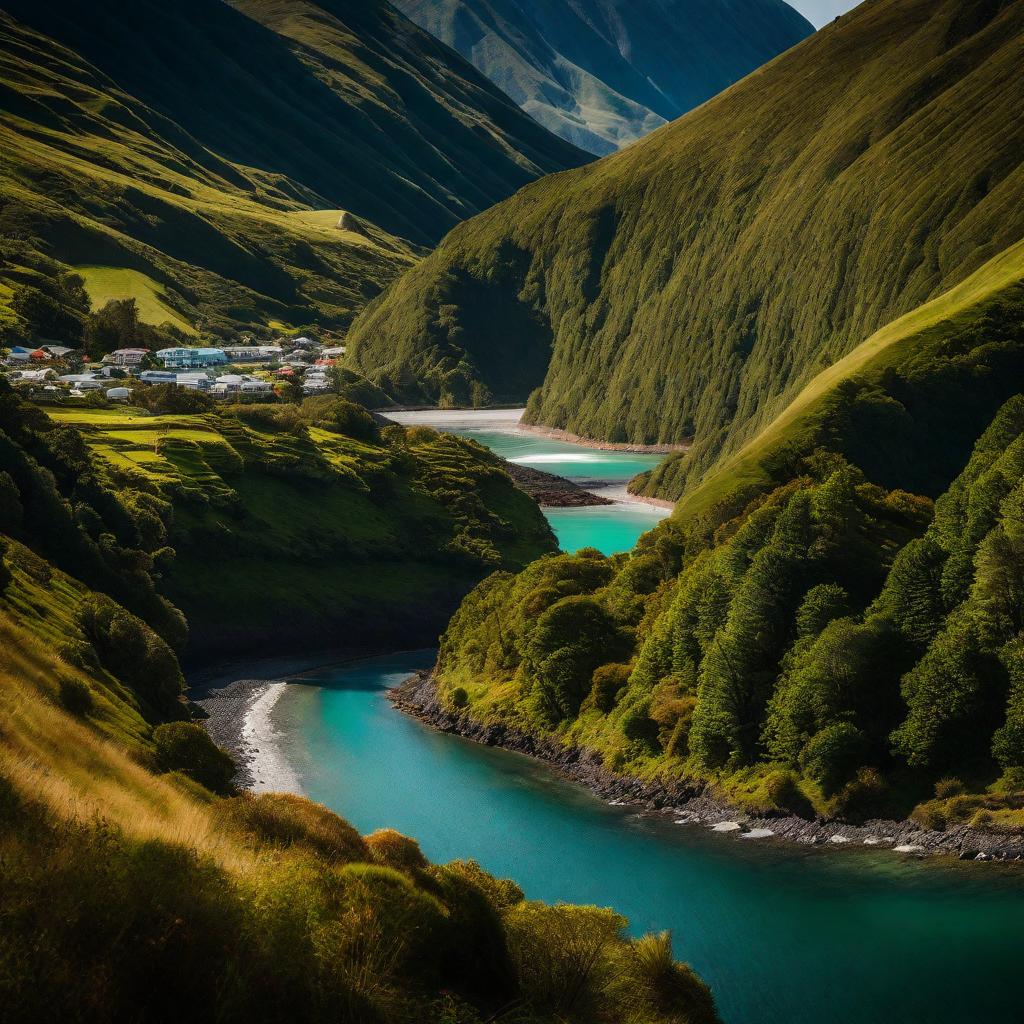Introduction : Top 5 Must-Visit Travel Destinations in Morocco
A. Overview of Morocco as a Travel Destination
Top 5 Must-Visit Travel Destinations in Morocco, a country located in North Africa, is a land of mesmerizing contrasts and rich heritage. Bordered by the Atlantic Ocean and the Mediterranean Sea, it offers a stunning array of landscapes ranging from the vast, golden sands of the Sahara Desert to the lush, green valleys of the Atlas Mountains. Morocco’s cities, with their vibrant souks, ancient medinas, and exquisite palaces, are a testament to the country’s long and diverse history. Known for its warm hospitality, flavorful cuisine, and unique architectural styles, Morocco captivates the hearts of travelers seeking both adventure and relaxation.
B. Importance of Cultural Immersion in Travel Experiences
Traveling to a new country is not just about visiting landmarks; it’s about immersing oneself in the local culture and gaining a deeper understanding of the people and their way of life. In Morocco, cultural immersion is an essential part of the travel experience. Engaging with local traditions, tasting authentic Moroccan dishes, participating in traditional ceremonies, and exploring the bustling markets provide invaluable insights into the country’s rich cultural tapestry. This deeper connection transforms a simple trip into a meaningful journey, fostering appreciation and respect for the diversity and heritage of the destination.
C. Setting the Stage for the Exploration of the Top 5 Destinations in Morocco
With its rich history and diverse landscapes, Morocco offers an array of fascinating destinations for travelers to explore. From the enchanting alleys of ancient medinas to the serene beauty of coastal towns, each location provides a unique glimpse into the country’s soul. This guide will take you through the top five destinations in Morocco, each offering its own blend of cultural significance, natural beauty, and unforgettable experiences. Embark on this journey to discover the magic of Marrakech, the historical depth of Fes, the picturesque charm of Chefchaouen, the majestic expanse of the Sahara Desert, and the coastal allure of Essaouira
I. Marrakech: The Jewel of Morocco
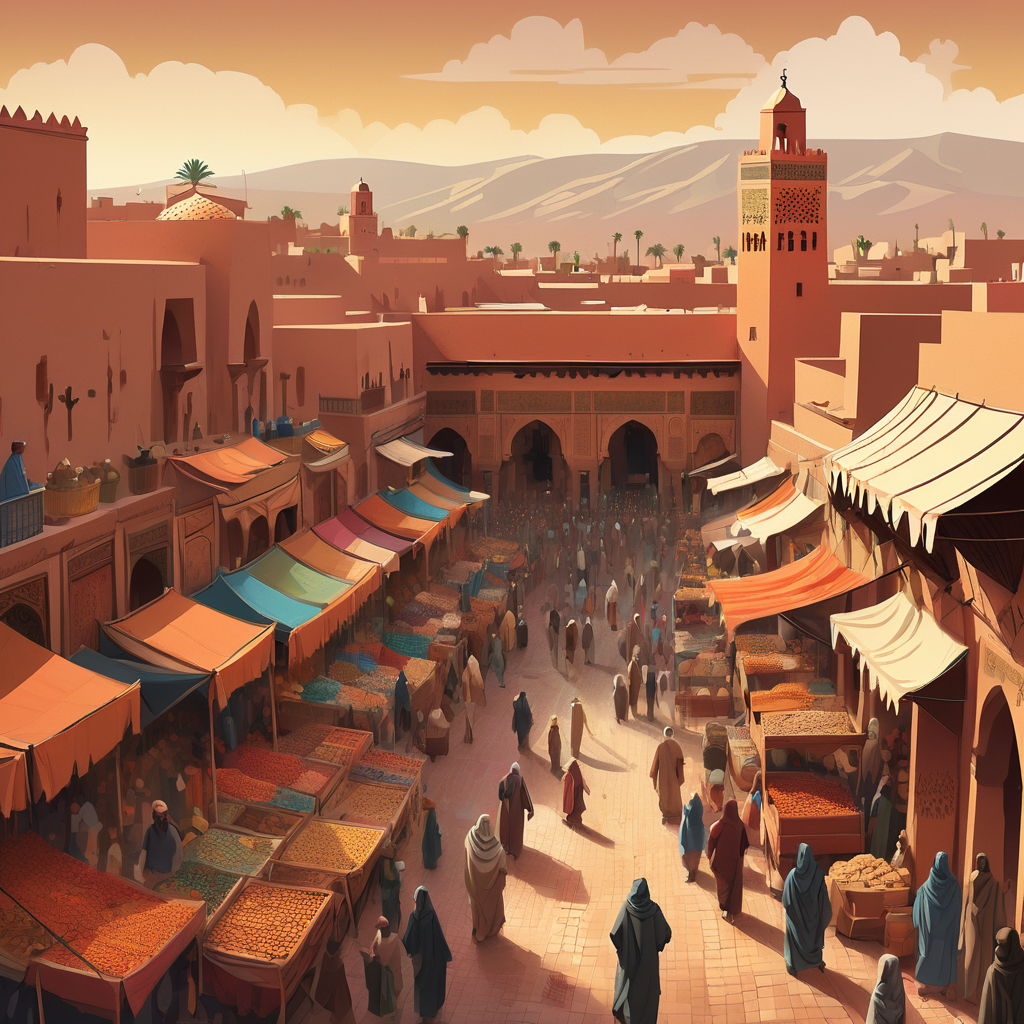
Historical Significance of Marrakech
Marrakech was founded in 1070 by the Almoravids and quickly became an important cultural, religious, and trading center. Its strategic location made it a nexus of commerce, linking sub-Saharan Africa with Europe and the Middle East.
Foundation and Early History
The city’s foundation marked the beginning of its long and storied history. Marrakech was the capital of the Almoravid dynasty and later became the capital of the Almohad Caliphate, reflecting its political and cultural significance.
Key Historical Landmarks
Koutoubia Mosque
The Koutoubia Mosque, with its towering minaret, is the largest mosque in Marrakech and a quintessential symbol of the city. Built in the 12th century, it stands as a testament to the architectural prowess of the Almohad dynasty.
Discovered in 1917, the Saadian Tombs date back to the time of Sultan Ahmad al-Mansur in the late 16th century. The tombs are renowned for their stunning architectural detail, including intricate carvings and colorful tile work.
Once a magnificent palace, El Badi now stands in ruins, offering a glimpse into the grandeur of the Saadian dynasty. Constructed in the late 16th century, it was considered one of the most beautiful palaces of its time.
Vibrant Souks and Bustling Medinas
The heart of Marrakech is undoubtedly its medina, a UNESCO World Heritage site filled with narrow alleys, traditional shops, and lively markets. Here, the past and present merge in a bustling atmosphere that is quintessentially Moroccan.
Overview of the Medina
The medina of Marrakech is a maze of narrow streets and alleyways, each turn revealing new surprises. From ancient mosques to vibrant markets, the medina is a sensory overload of sights, sounds, and smells.
Famous Souks in Marrakech
Souk Semmarine
One of the largest and most famous souks in Marrakech, Souk Semmarine is known for its vast array of goods, from spices and textiles to jewelry and pottery.
Souk El Kebir
Specializing in leather goods, Souk El Kebir is the place to find beautifully crafted bags, shoes, and belts, all made by skilled local artisans.
Rahba Kedima
Also known as the “Spice Square,” Rahba Kedima is a colorful market filled with stalls selling exotic spices, dried flowers, and traditional medicines.
Tips for Navigating the Souks
Navigating the souks can be overwhelming, especially for first-time visitors. It’s best to go with a guide or have a map handy. Don’t be afraid to haggle – bargaining is a part of the shopping experience in Morocco.
Experiencing Traditional Moroccan Cuisine in Marrakech
Moroccan cuisine is a feast for the senses, with its rich flavors, aromatic spices, and colorful presentation. Marrakech is the perfect place to indulge in traditional dishes and discover the culinary heritage of Morocco.
Introduction to Moroccan Cuisine
Moroccan cuisine is characterized by its use of a wide variety of spices and ingredients, creating complex and flavorful dishes. Common ingredients include lamb, chicken, fish, vegetables, and dried fruits, often combined with spices like cumin, coriander, and saffron.
Popular Dishes to Try
Tagine
Tagine is a slow-cooked stew typically made with meat, vegetables, and a blend of spices, all cooked in a conical clay pot of the same name. It’s a staple of Moroccan cuisine and comes in many variations.
Couscous
Couscous, often considered the national dish of Morocco, is made from steamed semolina grains and served with a stew of meat and vegetables. It’s traditionally prepared for special occasions.
Pastilla
Pastilla is a savory-sweet pie typically filled with pigeon meat, almonds, and spices, encased in layers of thin pastry. It’s a unique and delicious dish that showcases the complexity of Moroccan cuisine.
Best Places to Eat in Marrakech
Jemaa el-Fnaa Food Stalls
The food stalls at Jemaa el-Fnaa, Marrakech’s main square, offer a wide variety of traditional dishes. It’s a great place to sample street food and experience the vibrant atmosphere.
Local Restaurants and Cafes
There are countless restaurants and cafes throughout Marrakech offering everything from traditional Moroccan dishes to modern interpretations. Some notable mentions include Nomad, Al Fassia, and Dar Yacout.
Cooking Classes
For a hands-on experience, consider taking a cooking class. Many establishments offer classes where you can learn to prepare traditional Moroccan dishes and understand the intricacies of Moroccan cooking.
Exploring Marrakech’s Gardens and Palaces
Marrakech is not just about its bustling markets and historical sites; it also boasts beautiful gardens and palaces that offer a tranquil escape from the city’s hustle and bustle.
Majorelle Garden
Created by French painter Jacques Majorelle in the 1920s, Majorelle Garden is a stunning botanical garden featuring a variety of exotic plants, fountains, and vibrant blue buildings. It’s a serene oasis in the heart of the city.
Menara Gardens
Located at the edge of Marrakech, Menara Gardens is a vast garden with olive groves, a large pond, and stunning views of the Atlas Mountains. It’s a perfect spot for a peaceful stroll.
Bahia Palace
Bahia Palace is a 19th-century palace known for its beautiful architecture and lush gardens. It’s a splendid example of Moroccan design, with intricate tile work, carved wooden ceilings, and charming courtyards.
Cultural Activities and Experiences
To truly immerse yourself in Moroccan culture, participate in some of the traditional activities and experiences that Marrakech has to offer.
Traditional Moroccan Hammams
A visit to a traditional hammam (bathhouse) is a quintessential Moroccan experience. Hammams offer a range of services, from steam baths and scrubs to massages, providing a relaxing and rejuvenating experience.
Henna Art
Henna art is a popular tradition in Morocco, especially for special occasions. You can have intricate henna designs applied to your hands and feet by skilled artists in the medina.
Moroccan Tea Ceremonies
Moroccan tea, typically made with green tea and fresh mint, is a staple of Moroccan hospitality. Participating in a traditional tea ceremony is a wonderful way to experience local customs and enjoy the delicious beverage.
Day Trips and Excursions from Marrakech
Marrakech is a great base for exploring the surrounding areas, with several exciting day trip options available.
Atlas Mountains
The Atlas Mountains offer stunning landscapes and are perfect for hiking and trekking. You can explore traditional Berber villages and enjoy the breathtaking scenery.
Ourika Valley
Ourika Valley is a beautiful area located about an hour from Marrakech. It’s known for its picturesque landscapes, waterfalls, and traditional Berber culture.
Essaouira
Essaouira is a charming coastal town known for its relaxed atmosphere, beautiful beaches, and historic medina. It’s a perfect destination for a day trip from Marrakech.
Shopping in Marrakech
Marrakech is a shopper’s paradise, offering a wide range of traditional crafts and souvenirs.
Traditional Moroccan Crafts
From handmade carpets and pottery to leather goods and jewelry, Marrakech’s markets are filled with unique and beautiful crafts made by local artisans.
Best Places to Buy Souvenirs
In addition to the souks, you can find great souvenirs at shops like Ensemble Artisanal, which offers a wide range of quality crafts at fixed prices.
Bargaining Tips
Bargaining is expected in Moroccan markets. Start by offering about half of the asking price and negotiate from there. Always be polite and friendly – haggling is part of the fun!
Accommodation in Marrakech
Marrakech offers a variety of accommodation options to suit every budget and preference.
Riads
Riads are traditional Moroccan houses with interior courtyards, often converted into boutique hotels. Staying in a riad offers a unique and authentic experience.
Luxury Hotels
For those seeking luxury, Marrakech has several high-end hotels and resorts offering world-class amenities and service. Some notable options include La Mamounia, Royal Mansour, and the Four Seasons.
Budget Options
There are also plenty of budget-friendly accommodations in Marrakech, from hostels to guesthouses, offering comfortable stays at affordable prices.
Getting Around Marrakech
Navigating Marrakech can be an adventure in itself. Here are some tips to help you get around.
Public Transportation
Marrakech has a reliable network of buses and trams that can take you around the city.
Taxis and Car Rentals
Taxis are a convenient way to get around, but make sure to agree on a fare before starting your journey. Car rentals are also available for those who prefer to explore on their own.
Walking Tours
Walking is one of the best ways to explore the medina. Many companies offer guided tours that provide valuable insights into the history and culture of Marrakech.
Safety Tips for Travelers
Marrakech is generally safe for travelers, but it’s always good to take some precautions.
Health and Safety Advice
Make sure to stay hydrated, use sunscreen, and be cautious with street food if you have a sensitive stomach.
Cultural Etiquette
Respect local customs and dress modestly, especially when visiting religious sites. It’s also polite to ask for permission before taking photos of people.
Staying Connected
Consider getting a local SIM card for your phone to stay connected and have access to maps and other useful apps.
II. Chefchaouen : The Blue Pearl of Morocco
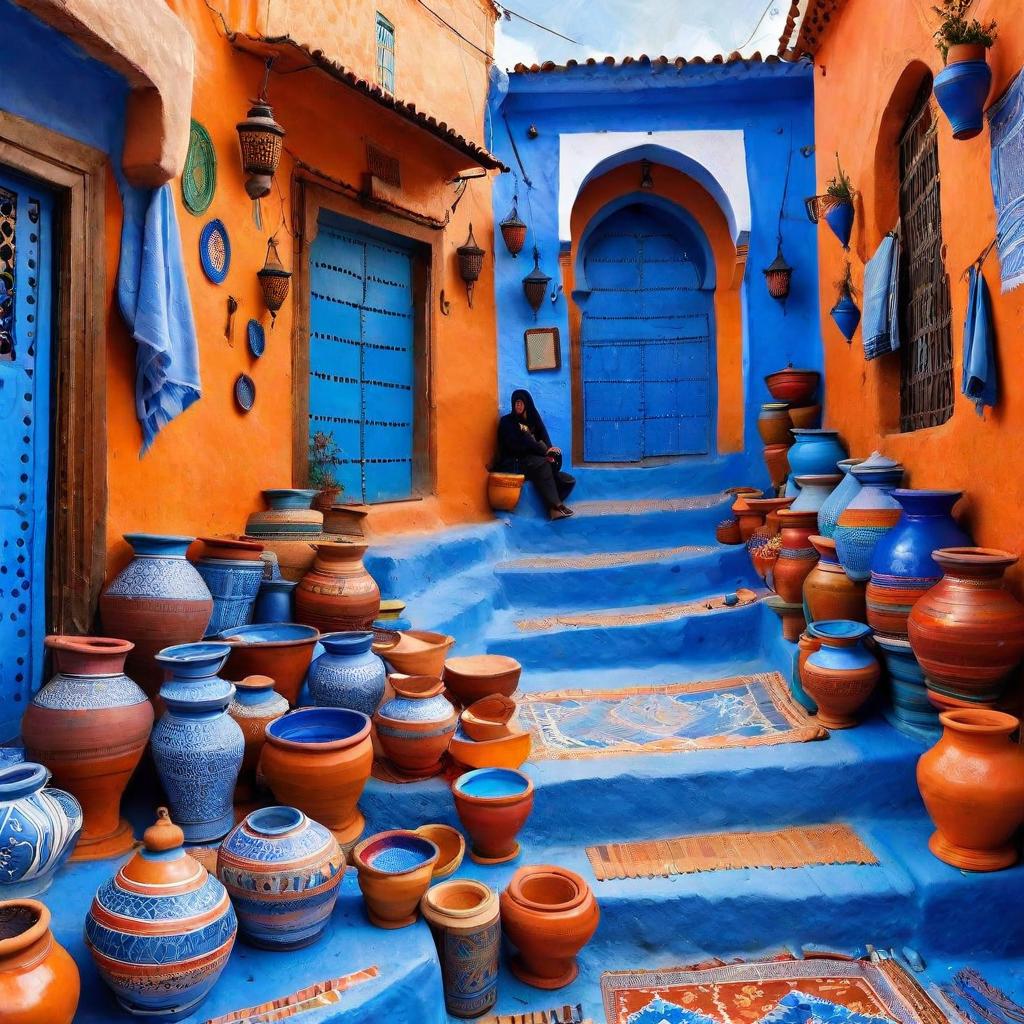
Unique Blue-Colored Architecture
One of the most enchanting features of Chefchaouen is its blue-colored architecture. The entire town is painted in various shades of blue, creating a dreamlike atmosphere.
History Behind the Blue Color
The tradition of painting the buildings blue dates back to the 15th century when Jewish refugees fleeing the Spanish Inquisition settled in Chefchaouen. They painted the town blue to symbolize the sky and heaven, and to remind them of God. Over time, this practice continued and became a defining characteristic of the town.
Key Areas to Explore
Medina
The medina of Chefchaouen is a labyrinth of narrow, winding streets, each more enchanting than the last. The blue walls, adorned with colorful flowers and intricate doorways, make every corner a photographer’s dream.
Uta el-Hammam Square
The central square of Chefchaouen, Uta el-Hammam, is a bustling hub of activity. Surrounded by charming cafes and restaurants, it’s the perfect place to sit back, relax, and soak in the vibrant atmosphere.
Photogenic Spots and Tips for Photography
Chefchaouen is a paradise for photography enthusiasts. Some of the most photogenic spots include the steps leading up to the Ras Elma river, the picturesque alleyways of the medina, and the panoramic views from the Spanish Mosque. To capture the best shots, visit early in the morning or late in the afternoon when the light is soft and golden.
Rich Art and Craft Scene in Chefchaouen
Chefchaouen is not just about its blue walls; it’s also a hub for traditional Moroccan crafts and art.
Overview of Local Crafts
The town is known for its rich artisan traditions, with many local craftsmen and women continuing to produce beautiful handmade goods using age-old techniques.
Traditional Weaving and Textiles
One of the most notable crafts in Chefchaouen is traditional weaving. The town’s markets are filled with vibrant, handwoven textiles, including rugs, blankets, and scarves. These textiles are made using traditional methods passed down through generations.
Pottery and Ceramics
Another prominent craft is pottery. Chefchaouen’s ceramics are renowned for their intricate designs and bright colors. You can find everything from decorative plates to functional kitchenware.
Local Markets and Artisan Shops
Exploring the local markets and artisan shops is a must. Some of the best places to shop include the souks in the medina and the shops around Uta el-Hammam Square. Here, you can buy unique souvenirs and support local artisans.
Exploring the Natural Beauty of the Rif Mountains
Beyond its blue walls, Chefchaouen is surrounded by the stunning natural beauty of the Rif Mountains.
Introduction to the Rif Mountains
The Rif Mountains offer a dramatic backdrop to Chefchaouen and are perfect for outdoor enthusiasts. The region is known for its lush valleys, rugged peaks, and diverse flora and fauna.
Popular Hiking Trails
Jebel el-Kelaa
One of the most popular hikes in the area is the trail to Jebel el-Kelaa. The hike offers spectacular views of Chefchaouen and the surrounding mountains. It’s a moderately challenging trail, suitable for those with a good level of fitness.
Talassemtane National Park
Talassemtane National Park is another great destination for hikers. The park is home to a variety of wildlife and offers several trails that take you through beautiful forests, past waterfalls, and up to stunning viewpoints.
Flora and Fauna of the Region
The Rif Mountains are home to a diverse range of plant and animal species. You’ll find everything from oak and cedar forests to wildflowers and medicinal herbs. Wildlife enthusiasts might spot Barbary macaques, wild boars, and various bird species.
Cultural Experiences in Chefchaouen
To fully appreciate Chefchaouen, immerse yourself in the local culture and traditions.
Traditional Moroccan Hammams
Visiting a traditional Moroccan hammam (bathhouse) is a relaxing and culturally enriching experience. Hammams offer steam baths, scrubs, and massages, providing a great way to unwind after a day of exploring.
Local Cuisine and Dining Spots
Chefchaouen’s cuisine is a delightful blend of Moroccan flavors. Some must-try dishes include tagine, couscous, and fresh goat cheese. For an authentic dining experience, visit local restaurants like Bab Ssour and Aladdin Restaurant.
Festivals and Events
Chefchaouen hosts several festivals and events throughout the year, celebrating everything from music and art to local culture and traditions. The most notable event is the Andalusian Music Festival, which attracts performers from across the region.
Accommodation in Chefchaouen
Chefchaouen offers a variety of accommodation options to suit every budget and preference.
Riads and Guesthouses
Staying in a riad or guesthouse is a popular choice, offering a unique and intimate experience. These traditional Moroccan homes often feature beautiful courtyards, terraces, and personalized service.
Budget Options
For budget travelers, there are plenty of affordable hostels and guesthouses. Places like Hostel Souika and Riad Baraka offer comfortable accommodations at reasonable prices.
Luxury Stays
If you’re looking for a more luxurious experience, Chefchaouen has several high-end hotels and riads, such as Lina Ryad & Spa and Dar Echchaouen, offering top-notch amenities and stunning views.
Day Trips and Excursions from Chefchaouen
Chefchaouen is a great base for exploring the surrounding areas, with several exciting day trips available.
Akchour Waterfalls
Akchour Waterfalls, located about 30 kilometers from Chefchaouen, is a popular destination for nature lovers. The hike to the waterfalls takes you through beautiful landscapes and offers a refreshing escape from the city.
God’s Bridge
Another natural wonder near Chefchaouen is God’s Bridge, a stunning rock formation spanning a gorge. The hike to God’s Bridge is moderately challenging and offers spectacular views.
Tangier
Tangier, a bustling port city, is also within reach for a day trip. Explore its historic medina, visit the famous Caves of Hercules, and enjoy the vibrant atmosphere of this cosmopolitan city.
Shopping in Chefchaouen
Shopping in Chefchaouen is a delight, with its markets and shops offering a wide range of unique items.
Souvenirs to Buy
Some popular souvenirs to buy include handwoven textiles, pottery, leather goods, and traditional Moroccan spices. These items make great gifts and mementos of your trip.
Best Markets and Shops
The best places to shop include the souks in the medina and the artisan shops around Uta el-Hammam Square. Take your time to explore and find unique treasures.
Bargaining Tips
Bargaining is a common practice in Moroccan markets. Start by offering about half of the asking price and negotiate from there. Remember to be polite and enjoy the process.
Getting Around Chefchaouen
Navigating Chefchaouen is a breeze, especially if you know the best ways to get around.
Walking in the Medina
The medina is best explored on foot. Its narrow streets are pedestrian-friendly, and walking allows you to fully appreciate the town’s beauty.
Public Transportation
While Chefchaouen is a small town, public transportation is available. Buses and shared taxis are common modes of transport for traveling to nearby towns and cities.
Car Rentals and Taxis
For more flexibility, consider renting a car. This is especially useful if you plan to explore the surrounding areas. Taxis are also readily available for short trips within the town.
Safety Tips for Travelers
When traveling to Chefchaouen, it’s important to stay safe and respect local customs.
Health and Safety Advice
Always drink bottled or filtered water, and be cautious with street food. Carry a basic first aid kit and any necessary medications.
Cultural Etiquette
Moroccan culture is rich and deeply rooted in tradition. Dress modestly, especially when visiting religious sites, and always ask for permission before taking photos of people.
III. Fes: The Heart of Moroccan Heritage
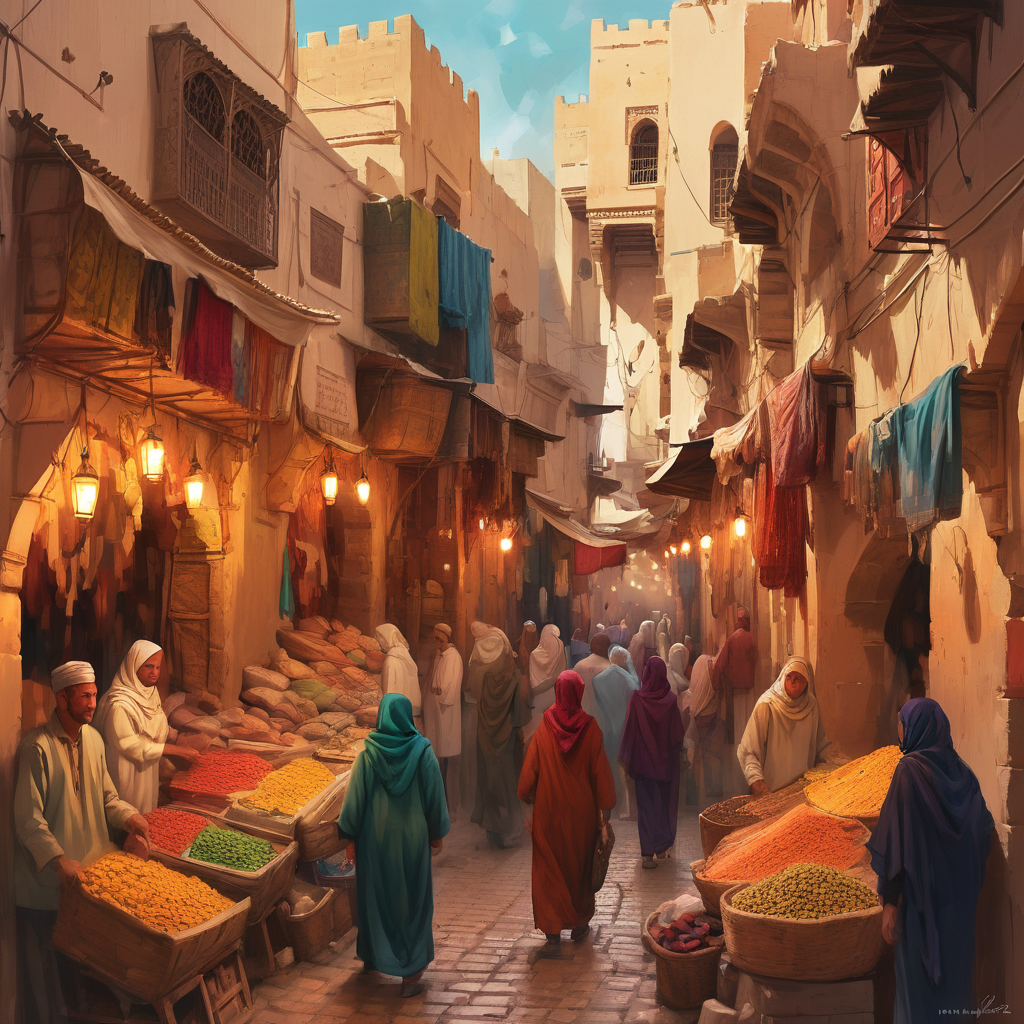
Ancient Medina and UNESCO World Heritage Sites
The medina of Fes, Fes el-Bali, is a sprawling, labyrinthine network of narrow streets and alleys that transport visitors back to medieval times. Recognized as a UNESCO World Heritage site, it’s a treasure trove of historical and architectural wonders.
Introduction to the Fes el-Bali
Fes el-Bali, the oldest walled part of Fes, is a fascinating maze of over 9,000 winding streets. Established in the 9th century, it’s one of the largest car-free urban areas in the world, preserving its traditional character and charm.
Key Landmarks in Fes el-Bali
Bou Inania Madrasa
The Bou Inania Madrasa, built in the 14th century, is a stunning example of Marinid architecture. This religious school features intricate tile work, elaborate stucco carvings, and beautiful wooden screens, making it a must-visit landmark.
Al-Attarine Madrasa
Another architectural gem, the Al-Attarine Madrasa, showcases exquisite craftsmanship. Located near the Al-Qarawiyyin Mosque, it’s renowned for its richly decorated courtyard and serene ambiance.
Chouara Tannery
The Chouara Tannery offers a glimpse into the traditional leather-making process that has remained unchanged for centuries. Watching the workers dye hides in vibrant colors is a unique and memorable experience.
Exploring the Labyrinthine Streets
Navigating the medina can be daunting, but getting lost is part of the adventure. Each turn reveals hidden treasures, from bustling souks and historic mosques to cozy cafes and artisan workshops. Hiring a local guide can enhance the experience, providing insights and stories about the medina’s history and culture.
Traditional Moroccan Cultural Experiences in Fes
Fes is a living museum of Moroccan traditions, where you can immerse yourself in the country’s rich cultural heritage.
Moroccan Cuisine and Cooking Classes
Fes is a culinary delight, offering a range of traditional Moroccan dishes. Don’t miss the chance to take a cooking class and learn how to prepare classics like tagine, couscous, and pastilla. These classes often include a trip to the local market to select fresh ingredients.
Hammams and Traditional Moroccan Baths
Experience the luxury of a traditional Moroccan hammam. These communal bathhouses offer a unique way to relax and rejuvenate, with steam baths, exfoliating scrubs, and soothing massages. Hammam Moulay Yacoub is one of the most famous in Fes, known for its healing mineral waters.
Festivals and Cultural Events
Fes hosts several festivals throughout the year, celebrating everything from music and dance to religious and cultural traditions. The Fes Festival of World Sacred Music is particularly noteworthy, attracting performers from around the globe for a week of enchanting performances.
Visiting the Oldest University in the World, Al-Qarawiyyin
The University of Al-Qarawiyyin, founded in 859 AD by Fatima al-Fihri, is the world’s oldest continuously operating educational institution.
History and Significance of Al-Qarawiyyin
Al-Qarawiyyin has played a crucial role in the intellectual and cultural life of the Muslim world. It has been a center for religious and scientific studies, producing numerous scholars and contributing to the spread of knowledge.
Architecture and Key Features
The university complex includes a mosque, library, and several lecture halls. Its architecture is a blend of traditional Moroccan and Islamic styles, featuring intricate mosaics, elegant arches, and beautifully decorated courtyards.
Impact on Global Education
Al-Qarawiyyin’s influence extends beyond Morocco. It has been a significant center of learning for scholars from various parts of the world, including Europe, helping to bridge cultural and intellectual exchanges between different civilizations.
Craftsmanship and Artisans in Fes
Fes is renowned for its skilled artisans who produce some of the finest traditional crafts in Morocco.
Pottery and Ceramics
The city’s pottery and ceramics are famous for their intricate designs and vibrant colors. Visit the Art Naji pottery workshop to see artisans at work and purchase beautiful hand-painted pieces.
Leatherwork
Fes’s tanneries produce high-quality leather goods, including bags, belts, and slippers. The distinctive smell of the tanneries and the sight of colorful dye pits make for a memorable visit.
Metalwork and Zellige Tile Making
Fes is also known for its fine metalwork and zellige (mosaic tile) craftsmanship. Artisans create stunning decorative pieces, from intricately designed lanterns to beautifully patterned tiles that adorn many of the city’s buildings.
Accommodation in Fes
Fes offers a range of accommodation options to suit every budget and preference.
Staying in a Riad
Staying in a riad, a traditional Moroccan house with an interior garden or courtyard, is a unique experience. Riads like Riad Laaroussa and Riad Fes offer luxurious accommodations with personalized service and authentic decor.
Budget-Friendly Options
For budget travelers, there are plenty of affordable hostels and guesthouses. Options like Funky Fes Hostel and Dar Rabha provide comfortable stays at reasonable prices.
Luxury Hotels
If you’re looking for a more luxurious experience, Fes has several high-end hotels. The Palais Amani and Hotel Sahrai offer world-class amenities, stunning views, and exceptional service.
Day Trips and Excursions from Fes
Fes is a great base for exploring the surrounding region, with several interesting day trips available.
Volubilis
The ancient Roman ruins of Volubilis, a UNESCO World Heritage site, are located about an hour’s drive from Fes. The well-preserved mosaics and impressive structures provide a fascinating glimpse into Roman history.
Meknes
Meknes, one of Morocco’s imperial cities, is another great day trip destination. Visit the grand Bab Mansour gate, the Mausoleum of Moulay Ismail, and the bustling Medina of Meknes.
Middle Atlas Mountains
For nature lovers, the Middle Atlas Mountains offer a scenic escape. Explore the cedar forests, visit the charming town of Ifrane, and enjoy the tranquility of the mountain landscapes.
Shopping in Fes
Shopping in Fes is an adventure, with its bustling markets and vibrant souks offering a wide range of unique items.
Souvenirs to Buy
Popular souvenirs include handwoven textiles, pottery, leather goods, and traditional Moroccan spices. These items make perfect gifts and mementos of your trip.
Best Markets and Shops
The best places to shop are the souks in the medina and artisan shops around Fes el-Bali. Take your time to explore and find unique treasures.
Bargaining Tips
Bargaining is a common practice in Moroccan markets. Start by offering about half of the asking price and negotiate from there. Remember to be polite and enjoy the process.
IV. Sahara Desert: A Majestic Adventure
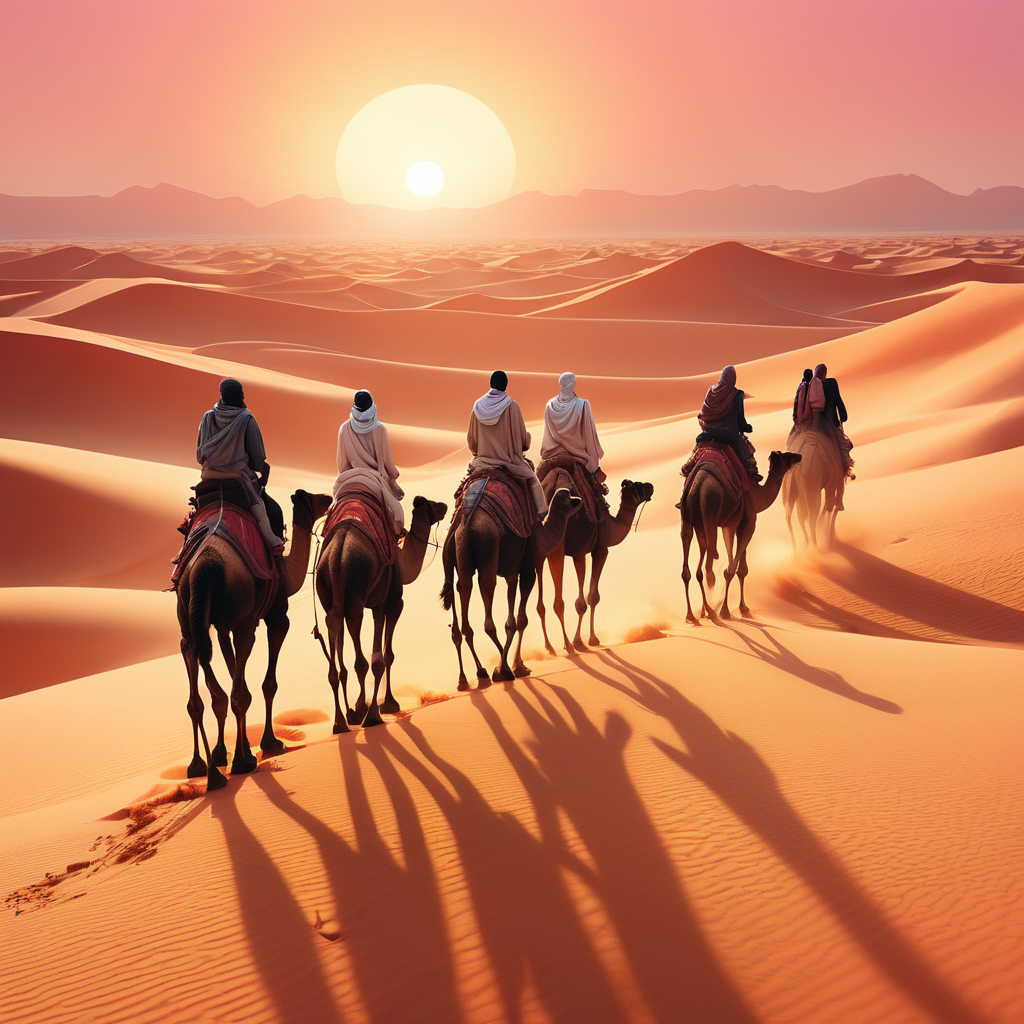
Camel Treks and Camping Under the Stars
Venturing into the Sahara Desert often begins with a camel trek, a timeless mode of transportation that allows travelers to traverse the vast expanse of dunes with ease.
Exploring the Desert on Camelback
Camels, known as the “ships of the desert,” provide a steady and serene way to navigate the sandy terrain. As you embark on a camel trek, you’ll witness the ever-shifting landscape of towering dunes and expansive plains, immersing yourself in the tranquility of the desert.
Setting Up Camp in the Sahara
As the day draws to a close, it’s time to set up camp beneath the vast desert sky. Bedouin-style tents or traditional Berber camps offer shelter from the elements while still allowing you to experience the true essence of desert living.
Stargazing in the Desert Night
As night falls, the Sahara comes alive with the brilliance of a thousand stars. With minimal light pollution, the desert offers unparalleled opportunities for stargazing. Marvel at the Milky Way stretching across the heavens and lose yourself in the timeless beauty of the cosmos.
Witnessing the Breathtaking Sunrise and Sunset in the Desert
One of the most magical moments in the Sahara is witnessing the transition between day and night, as the sun casts its golden glow over the desert landscape.
Magical Moments in the Sahara
As dawn breaks, the desert is bathed in a soft, ethereal light, painting the dunes in hues of pink and gold. The stillness of the morning is broken only by the gentle rustle of the wind, creating a sense of serenity and peace.
Capturing the Beauty of Dawn and Dusk
Sunset in the Sahara is equally enchanting, as the sun dips below the horizon, casting a warm, amber glow over the desert sands. With each passing moment, the colors shift and change, creating a breathtaking display of nature’s beauty.
Reflecting on the Vastness of the Desert Landscape
As you watch the sun rise and set in the Sahara, you can’t help but feel a sense of awe and wonder at the sheer vastness of the desert landscape. In these moments, surrounded by the timeless beauty of the desert, you’re reminded of the power and majesty of the natural world.
Experiencing Berber Nomadic Life in the Sahara
The Sahara is not just a place of stunning natural beauty; it’s also home to vibrant communities with rich cultural traditions.
Meeting the Berber Tribes
The Berbers, indigenous peoples of North Africa, have called the Sahara home for centuries. Visiting a Berber camp offers a unique opportunity to learn about their nomadic way of life, handed down through generations.
Learning About Their Customs and Traditions
From traditional dress and cuisine to music and storytelling, the Berbers have a rich cultural heritage that they’re eager to share with visitors. Take the time to engage with local families and gain insights into their customs and traditions.
Participating in Cultural Activities
Many Sahara Desert tours offer opportunities to participate in cultural activities such as Berber music and dance performances, bread-making demonstrations, and camel races. These immersive experiences provide a deeper understanding of Berber life and culture.
Safety Tips for Desert Travelers
While exploring the Sahara Desert is an adventure of a lifetime, it’s essential to prioritize safety and preparedness.
Essential Items to Pack
When traveling in the desert, it’s crucial to pack plenty of water, sunscreen, a hat, sunglasses, and lightweight, breathable clothing. A first aid kit, flashlight, and compass are also essential items to have on hand.
Dealing With Extreme Temperatures
The Sahara can experience extreme temperatures, with scorching heat during the day and chilly nights. Dressing in layers and staying hydrated are key to staying comfortable in the desert environment.
Navigating Sand Dunes and Terrain
Navigating the desert terrain can be challenging, especially when trekking through sand dunes. It’s essential to follow your guide’s instructions and stay on designated paths to avoid getting lost or injured.
Choosing the Right Sahara Desert Tour
When planning a Sahara Desert adventure, choosing the right tour company can make all the difference.
Researching Tour Companies
Take the time to research different tour companies and read reviews from past travelers. Look for companies that prioritize safety, sustainability, and authentic cultural experiences.
Considering Duration and Itinerary
Sahara Desert tours vary in duration and itinerary, ranging from day trips to multi-day excursions. Consider your preferences and interests when selecting a tour that best suits your needs.
Reading Reviews and Testimonials
Before booking a Sahara Desert tour, be sure to read reviews and testimonials from other travelers. This will give you insight into the quality of the tour and the experiences of previous participants.
Preparing for Your Sahara Adventure
Embarking on a Sahara Desert adventure requires careful preparation, both physically and mentally.
Physical Fitness and Health Considerations
While camel treks and desert walks are accessible to most travelers, it’s essential to be in good physical health and have a reasonable level of fitness. If you have any medical conditions or concerns, consult with your healthcare provider before embarking on your desert journey.
Packing List Essentials
In addition to essential items like water, sunscreen, and appropriate clothing, be sure to pack a camera or smartphone to capture the stunning scenery, as well as a journal to record your experiences and reflections.
Mental Preparedness for the Desert Environment
Traveling in the desert can be a transformative experience, but it’s essential to be mentally prepared for the challenges and uncertainties that may arise. Embrace the spirit of adventure and approach your Sahara journey with an open mind and a sense of curiosity.
Environmental Awareness and Responsible Travel
As visitors to the Sahara Desert, it’s important to practice responsible travel and minimize our environmental impact.
Minimizing Environmental Impact
When exploring the desert, follow the principles of Leave No Trace, including packing out all trash, staying on designated trails, and respecting wildlife and vegetation. Avoid disturbing sensitive habitats and cultural sites, and minimize your use of plastic and other non-biodegradable materials.
Respecting Local Communities and Culture
Be respectful of the local communities and cultures you encounter in the Sahara Desert. Seek permission before taking photos of people or their property, and engage with locals in a culturally sensitive and respectful manner.
Supporting Sustainable Tourism Initiatives
Support tour operators and businesses that prioritize sustainability and responsible tourism practices. Look for eco-friendly accommodations, participate in community-based tourism initiatives, and choose tours that benefit local communities and conservation efforts.
V. Essaouira: The Coastal Gem of Morocco
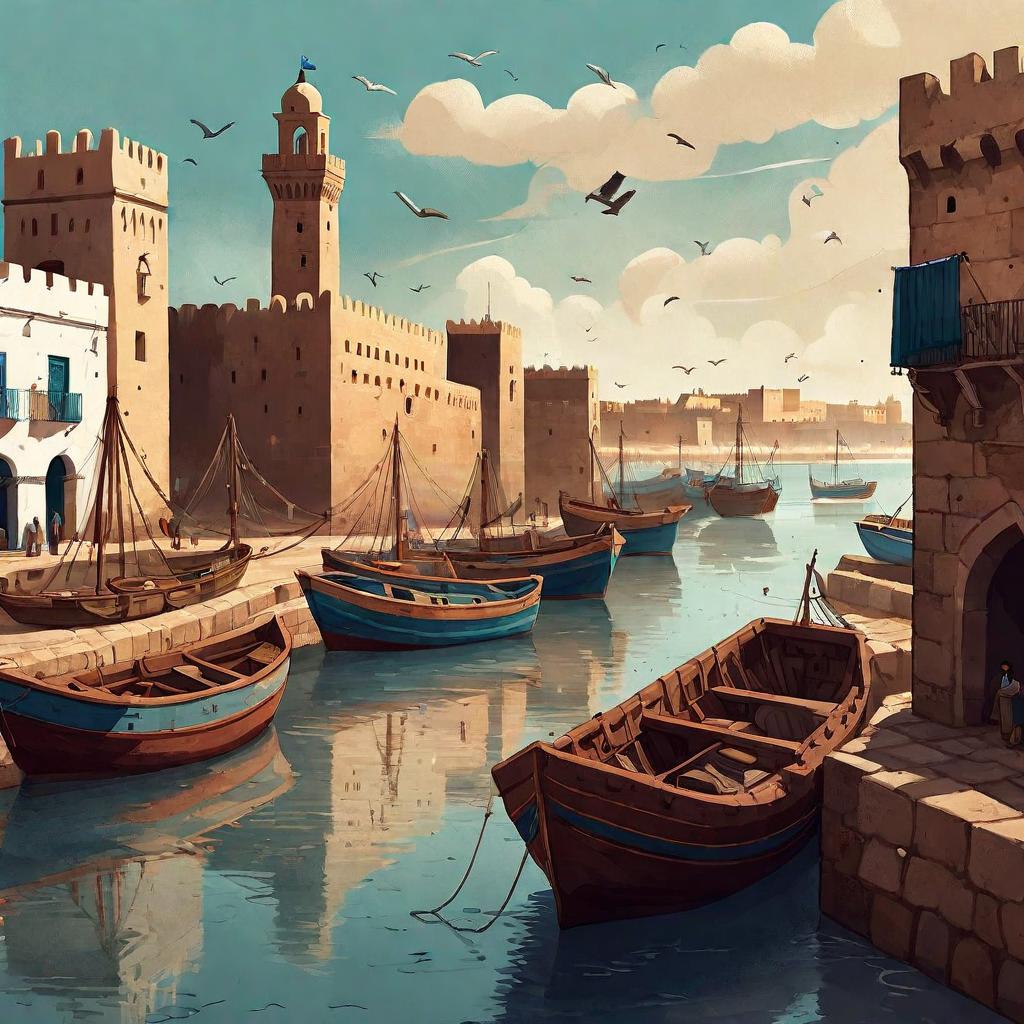
A. Relaxing on the pristine beaches of Essaouira
Located on the western coast of Morocco, Essaouira is a hidden gem known for its breathtaking beaches that stretch as far as the eye can. The soft golden sands, kissed by the gentle waves of the Atlantic Ocean, create a picture-perfect setting for relaxation and rejuvenation. Whether you’re looking to soak up the sun, take a leisurely stroll along the shore, or simply unwind with a good book in hand, the beaches of Essaouira offer the perfect escape from the hustle bustle of everyday life.
Plage Tagharte: This secluded beach is perfect for those seeking a peaceful retreat away from the crowds.
Plage de Safi: Known for its strong winds, this beach is a haven for kite surfers and windsurfers.
Plage de Sidi Kaouki: A popular spot for beachgoers looking to enjoy the tranquility of nature and catch a glimpse of surfers riding the waves.
B. Exploring the historic port city and its fortifications
Steeped in history and culture, Essaouira’s medina is a UNESCO World Heritage Site that is sure to captivate your senses. As you wander through the winding alleyways, lined with vibrant shops selling local handicrafts and delicious street food, you’ll stumble upon historical landmarks such as the Skala de la Ville and Sqala du Port. The imposing fortifications that once protected the city from invasions offer a glimpse into Essaouira’s rich past, making it a must-visit destination for history buffs and culture enthusiasts alike.
Skala de la Ville: A historic bastion offering panoramic views of the ocean and the city.
Sqala du Port: An ancient fortress that served as a defensive structure against maritime attacks.
Medina of Essaouira: Lose yourself in the maze-like streets of the medina and discover hidden treasures at every turn.
C. Enjoying water sports and fresh seafood in Essaouira
For the adventure seekers and food enthusiasts, Essaouira has something special in store. The strong winds that sweep across the coastline create the perfect conditions for water sports such as windsurfing, kite surfing, and sailing. Whether you’re a seasoned pro or a first-time enthusiast, the waters of Essaouira beckon you to take on new challenges and create unforgettable memories. After a day of thrilling activities, be sure to satisfy your taste buds with succulent seafood dishes at one of the many beachfront restaurants that line the coast.
Windsurfing: Feel the rush of adrenaline as you glide across the water and conquer the waves.
Kite Surfing: Soar through the air with a kite attached to your board and experience the thrill of being one with the elements.
Fresh Seafood: Indulge in a seafood feast at a local restaurant and savor the flavors of the ocean.
Essaouira is not just a destination; it’s an experience that will stay with you long after you’ve left its shores. With its blend of natural beauty, cultural heritage, and thrilling activities, this coastal gem is sure to capture your heart and leave you yearning for more. Embrace the charm of Essaouira and create memories that will last a lifetime.
ALSO READ : 10 Best Places for Solo Travelling in Peru
Conclusion
A journey into the Sahara Desert is an adventure like no other, offering a unique blend of natural beauty, cultural richness, and timeless wonder. Whether you’re marveling at the vastness of the desert landscape, sharing stories with Berber tribes, or gazing at the stars from your desert camp, the Sahara promises an experience that will stay with you forever.
Marrakech: Immerse yourself in the bustling souks, marvel at the intricate architecture of the medina, and relax in the serene gardens of this iconic city.
Fes: Step back in time as you wander through the maze-like streets of the medina, home to the world’s oldest university and countless historic treasures.
Chefchaouen: Known as the “Blue City,” Chefchaouen enchants visitors with its picturesque blue-washed buildings nestled in the Rif Mountains.
Sahara Desert: Experience the magic of the desert with a camel trek across the rolling dunes, camp under the stars, and witness the breathtaking sunrise and sunset.
Essaouira: Explore the charming coastal town of Essaouira, where ancient fortifications meet vibrant markets and windswept beaches.
B. One of the most remarkable aspects of traveling in Morocco is the diverse range of experiences it offers. From the bustling streets of Marrakech to the tranquility of the Sahara Desert, each destination presents a unique opportunity to immerse yourself in the rich tapestry of Moroccan culture and landscapes.
In Marrakech, lose yourself in the vibrant colors and sounds of the souks, where you can haggle for spices, textiles, and handicrafts. Meanwhile, in the ancient city of Fes, wander through narrow alleyways lined with centuries-old buildings, and discover hidden gems around every corner.
For a complete change of pace, head to the Sahara Desert, where you can embark on a once-in-a-lifetime adventure through the dramatic sand dunes, spend a night under the starry sky in a traditional Berber camp, and witness the breathtaking beauty of sunrise and sunset over the endless expanse of sand.
And let’s not forget about the coastal charm of cities like Essaouira, where you can stroll along windswept beaches, explore historic fortifications, and savor freshly caught seafood at local cafes.
C. Morocco is a country that beckons adventurers to explore its beauty and diversity. Whether you’re drawn to the bustling energy of its cities, the tranquility of its desert landscapes, or the laid-back vibe of its coastal towns, there’s something for everyone to discover and enjoy.
FAQs
Is it safe to visit the Sahara Desert?
- Yes, Sahara Desert tours are generally safe when conducted with reputable tour companies and experienced guides.
What is the best time of year to visit the Sahara?
- The best time to visit the Sahara is during the cooler months of October to April when temperatures are more comfortable.
How long does a typical Sahara Desert tour last?
- Sahara Desert tours can vary in duration, ranging from day trips to multi-day excursions lasting several days.
What should I wear in the desert?
- Lightweight, breathable clothing that provides sun protection is recommended, along with a hat, sunglasses, and sturdy footwear.
Can I ride a quad bike or dune buggy in the Sahara?
- Yes, many Sahara Desert tours offer the option to ride quad bikes or dune buggies as part of the experience.
6. Is Morocco a safe travel destination?
Morocco is generally considered a safe travel destination for tourists. However, like any other country, it’s essential to take basic precautions to ensure your safety. Avoid displaying valuables in public, be cautious of your surroundings, and follow the advice of local authorities. In addition, it’s recommended to stay informed about any travel advisories or warnings issued by your home country’s government.
7. What is the best time of the year to visit Morocco?
The best time to visit Morocco depends on your preferences and the activities you plan to pursue. Generally, the spring months of March to May and the fall months of September to November are considered the most pleasant times to visit, with moderate temperatures and fewer crowds. However, if you’re interested in experiencing Morocco’s vibrant festivals and cultural events, such as the Ramadan festivities or the Marrakech International Film Festival, you may want to plan your visit accordingly.
8. How can I best experience the local culture in Morocco during my travels?
To experience the rich cultural heritage of Morocco, immerse yourself in the local way of life by exploring the bustling souks, sampling traditional cuisine, and engaging with locals. Consider participating in cultural activities such as cooking classes, music performances, or guided tours of historical sites. Don’t be afraid to strike up conversations with locals and learn about their customs, traditions, and way of life. Additionally, respect local customs and traditions, such as dressing modestly in religious sites and asking permission before taking photographs of people.

